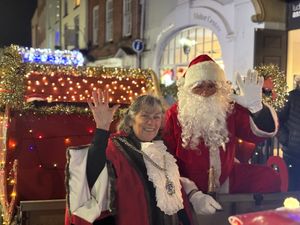Hitler's artwork to go under the hammer in Ludlow
This picture is purported to be from the mind and hand of one of the most evil figures of modern history – and it could be yours for about £6,000.

A clutch of four paintings ascribed to Adolf Hitler, and an unsigned one likely to have been by the Nazi leader, are to go up for sale next week at Ludlow Racecourse.
At the same auction, held by Shropshire firm Mullock's, will be top secret documents signed by Winston Churchill considering the building of a channel tunnel as long ago as 1914, when Churchill was First Lord of the Admiralty.
The Hitler paintings include a still life showing fruit, flowers and a clock, an Alpine bouquet with edelweiss, a scene showing the town gate at Dürnstein in the pretty Wachau valley, a popular tourist location in Hitler's native Austria, and a street scene, again likely to be in Dürnstein.
Each one is signed and up for sale with a price tag of between £5,000 and £7,000.
But possible more interesting – or creepy, depending on your point of view – is a fifth painting up for the same price that shows the grave of Geli Raubel, Hitler's half-niece that he was famously romantically infatuated with. It may have been painted by Hitler, but it is impossible to be sure.

Ben Jones, a consultant at Mullock's, said: "A remarkable painting in oil on canvass showing her grave with floral tributes, this is unsigned so it is impossible to say whether it can be attributed to Adolf Hitler.
"Raubel was Hitler’s niece and one time lover. She committed suicide in 1931 with Hitler’s pistol and there has always been speculation that he in fact murdered her. This was certainly the allied claim throughout the War.
"Conspiracy theories have abounded about their relationship and how she died, fuelled by the activities of the authorities in dealing with her death. Hitler famously did not attend the funeral but privately attended her grave three days later."
Also on sale are documents signed by Churchill discussing plans to build a channel tunnel – but with emergency measures that could be taken in case of war.
In the document, dated June 12, 1914, Churchill suggests: "A drawbridge should be fitted in one of the spans of the bridge.
"Means of flooding the tunnel should be provided, but it would not be necessary to use these means until war had actually begun between Britain and France.
"The guns of a single small cruiser could break down the bridge and absolutely prevent the passage of trains or troops along the railway line by night or day.
"On the other hand, if France is our friend and we want to keep the tunnel communication open, the command of the sea gives us the power to do so."
The document is up for £1,500 to £1,700. Mr Jones said: "As far as we are aware no other version of the channel tunnel document signed by Churchill is in existence.
"The Churchill Archives in Cambridge have a copy of this document but is unsigned," he added.





